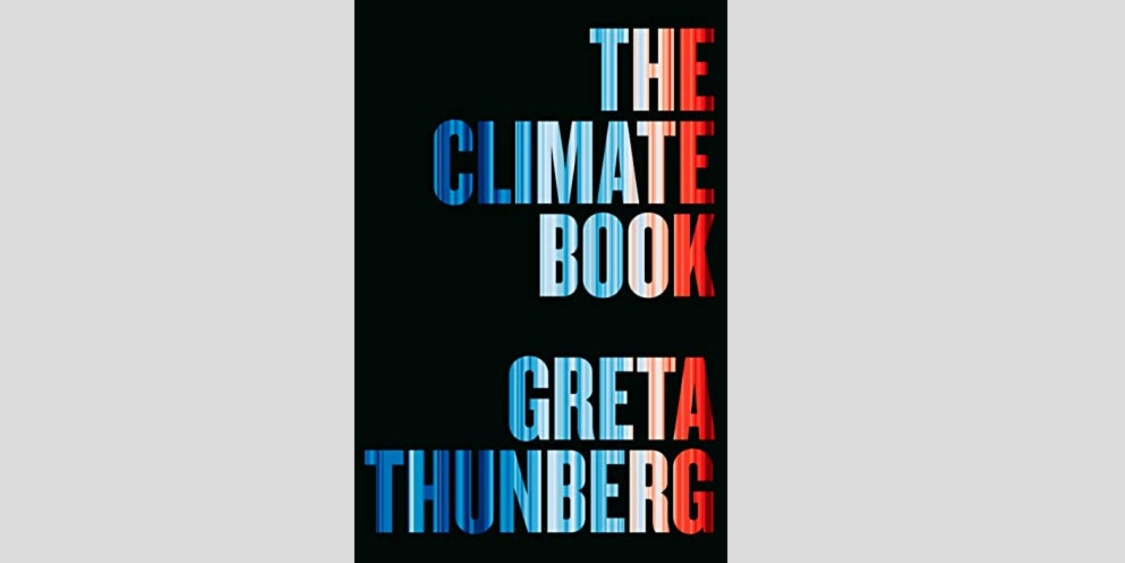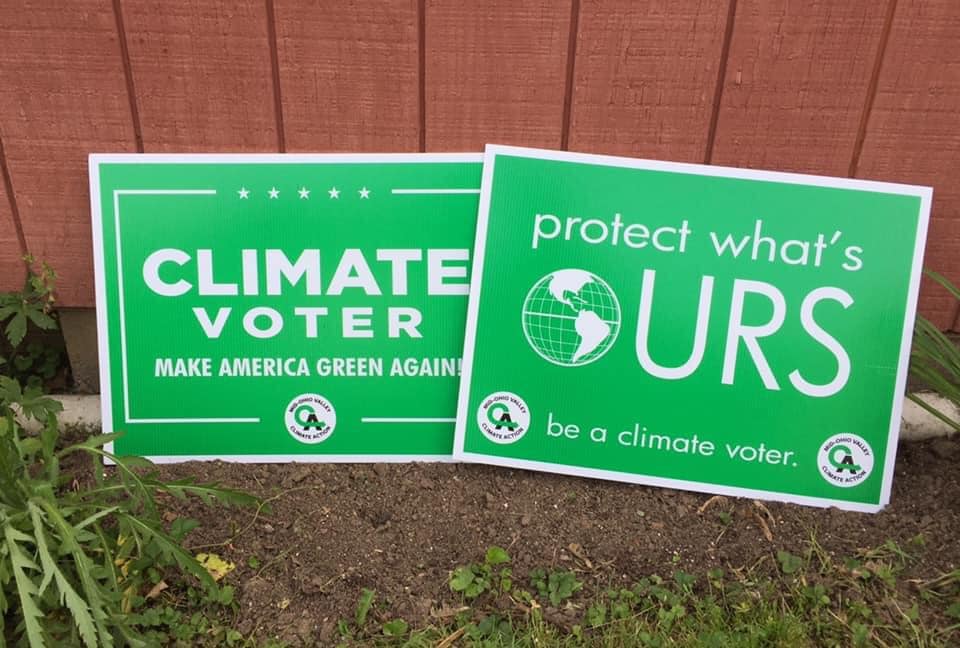Review by Cindy Ellis
In an online post, Eric Engle recommended this book. Eric is active in the Mid-Ohio Climate Action group, and he helps supply me and others with eye-catching “Climate Voter” signs.
So, from the library, I checked out The Climate Book by Greta Thunberg. I thought I knew something about climate crisis and its attendant issues. Turns out that what I knew was dwarfed by unrecognized threats and complications. And it is also clear that this comprehensive set of essays should not be sidelined as what some may perceive as routine doom and gloom.
Even the book’s cover conveys a message. Its design is “Warming Stripes,” a graphic visualization of data, in minimalist form, intended to show trends without distraction. In this case the bars simply get redder.
I read the book straight through. Alternately a person might look at the five expansive sections and choose to select an unfamiliar topic…or a familiar one. Thunberg wanted to create a “go to” book. She assembled contributors: scientists, economists, novelists, activists, and more. There is a wealth of information. At some point I ordered, from a thrift bookstore, my own copy so that I could underline, highlight, and put tabs.
The section headings are:
· “How Climate Works”
· “How Our Planet is Changing”
· “How it Affects Us”
· “What We’ve Done About It”
· “What We Must Do Now
Greta herself adds essays. In one of her early articles, she notes that she finds optimism in our current ease of communication. She sees it as key to spreading facts and combating misinformation.
As I became immersed in information new to me, I wanted to share. I tried posting online a quote each day from the chapters as I read them. Later though, I came to feel that dispatching single lines or short paragraphs was less than ideal. Nearly all of what I found that was new and riveting could not be presented out of context.
For example, I had not known about the reindeer. Nor about all the critical matters associated with permafrost. I cannot briefly convey the dismay raised by the description of reindeer calves now routinely starving to death due to disruption in what formerly was reliable snow cover. A member of the Nordic Sámi tribe wrote, “The elders are now talking about an emergency year that has lasted for over a decade, the end of which we cannot see.”
There was so much to find out about in regard to so many elements that have sustained us. About oceans, and about soil—and thus food crops—about “tipping points,” about our predicted inability to ADAPT, impacts of agriculture, and much more. And we need to read beyond “Drought is the consequence of a planet desperate to cool itself,” in order to grasp details of that desperation.
So, I will plan to enlarge on those online posts by sharing this review.
And to say that this book could hope to help us sort out our overload of messages, and with sorting out the source of money behind messages. It does not shy from speaking of those who benefit from inaction. “The biggest political donors in American history, the Koch brothers, were also the country’s biggest oil and gas barons; United States Senator Joe Manchin, who had taken more political donations from the fossil fuel industry than anyone else in Washington and personally has millions invested in coal, was single-handedly able to rewrite climate legislation in 2021.”
I hope that some will want to read The Climate Book, in parts or in whole, to gain insights on views that do not seem to change or to change quickly. I expect some will want to turn to “What We Must Do Now”, but it’s my hope that “What We’ve Done About It” won’t be ignored.
There are explanations and suggestions in the last two sections for applying all the “ammunition” one may learn in the first three sections … those about climate basics and details of change and its effects.
There’s an array of ideas. We might wonder if we can rise to these challenging times; to “Take the Jump” as a website of that name suggests. Six “shifts” are:
· End clutter: keep electronic products for at least seven years.
· Holiday local: take short-haul flights only once in three years.
· Eat green: adopt a plant-based diet and leave no waste.
· Dress retro: buy at most three new items of clothing a year.
· Travel fresh: don’t make use of private cars, if possible.
· Change the system: act to nudge and shift the wider system.
The latter portions of the book also make the effort to awaken us to the consequences of “greenwashing”, of media shortcomings, and of rampant consumerism.
Points are made about the fashion industry. For many of our readers and members “new threads” may mean a new pair of socks for our hiking boots, but we should know that, “Pressured to deliver orders of low-cost clothes under very tight deadlines, factories worldwide often push garment workers into an intense schedule of long hours with low wages, insecure contracts and a ban on organizing the workforce.”
The industry produces 2% of greenhouse gas emissions and makes heavy use of materials, water, chemicals and energy… “less than 1 per cent [of garments produced] are reused or recycled for new clothing.”
To wind up, I hope to convey optimism, as the book did.
But first here are some minor observations of The Climate Book. There is only the slightest mention of “point of use” in power schemes, and a fairer picture would be provided with some note of the few but real negatives to consider with wind and solar. Although the pages have a nice, non-slick feel, the print is quite small. The essays by Thunberg are printed on gray pages with print that is only slightly darker, making some of us squint.
Even so, “The Climate Book” is eye-opening. And optimistic.
Two voices saying so are the young activist Greta, and Robin Wall Kimmerer, an Anishinaabe/Potawatomi, author of Braiding Sweetgrass.
Robin speaks of, “…the One Bowl, One Spoon treaties” of her people. “The land is understood as the Bowl, filled by Mother Earth with everything we need. It is our responsibility to share it and keep the bowl full…Not a tiny one for some and a gouging shovel for others.”
Greta says, “Hope is taking action. It is stepping outside your comfort zone. If a bunch of weird schoolkids were able to get millions of people to start changing their lives, just imagine what we could all do it we tried.”
P.S. I can help you get one of these green signs! Reach out to the Voice editor at comms@wvhighlands.org


